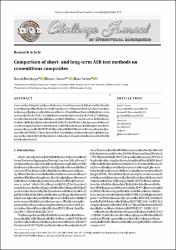| dc.contributor.author | Sivrikaya, Burak | |
| dc.contributor.author | Demir, İlhami | |
| dc.contributor.author | Sevim, Özer | |
| dc.date.accessioned | 2021-01-14T18:19:27Z | |
| dc.date.available | 2021-01-14T18:19:27Z | |
| dc.date.issued | 2020 | |
| dc.identifier.issn | 2149-8024 | |
| dc.identifier.issn | 2149-8024 | |
| dc.identifier.uri | https://doi.org/10.20528/cjsmec.2020.02.003 | |
| dc.identifier.uri | https://app.trdizin.gov.tr/makale/TXpjeU1qRTBOQT09 | |
| dc.identifier.uri | https://hdl.handle.net/20.500.12587/13675 | |
| dc.description.abstract | Concrete has a significant place in construction structures, is a material that can be easily damaged due to incorrect design, incorrect material selection. Concrete may be damaged by physical and chemical factors. One of these factors is the alkali-silica reaction (ASR). ASTM C1260, is a short-term test method, and ASTM C227, is a longterm test method, are used to measure effect of alkali-silica reaction. In this study, the effect of fly ash additive use with 0, 5, 10, 15, and 20 wt.% replacement of cement was investigated in short- and long-term ASR test methods. For this purpose, while samples prepared for ASTM C1260 were kept in NaOH solution 14-days, samples prepared for ASTM C227 were waited 360-days in normal water solution. As a result; mortar bars with 20% fly ash additive ratio were classified as harmless for ASR in both test methods. | en_US |
| dc.language.iso | eng | en_US |
| dc.relation.isversionof | 10.20528/cjsmec.2020.02.003 | en_US |
| dc.rights | info:eu-repo/semantics/openAccess | en_US |
| dc.title | Comparison of short- and long-term ASR test methods on cementitious composites | en_US |
| dc.type | article | en_US |
| dc.identifier.volume | 6 | en_US |
| dc.identifier.issue | 2 | en_US |
| dc.identifier.startpage | 68 | en_US |
| dc.identifier.endpage | 72 | en_US |
| dc.relation.journal | Challenge Journal of Structural Mechanics | en_US |
| dc.relation.publicationcategory | Makale - Ulusal Hakemli Dergi - Kurum Öğretim Elemanı | en_US |
















